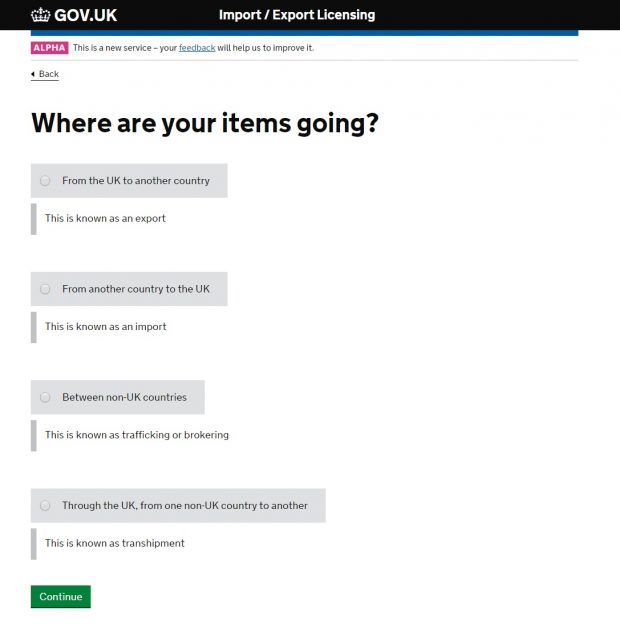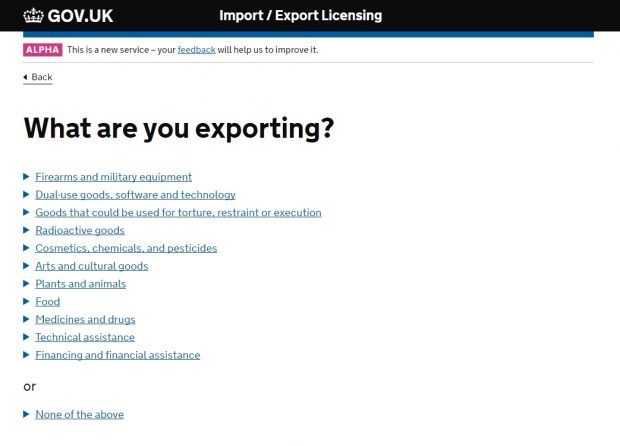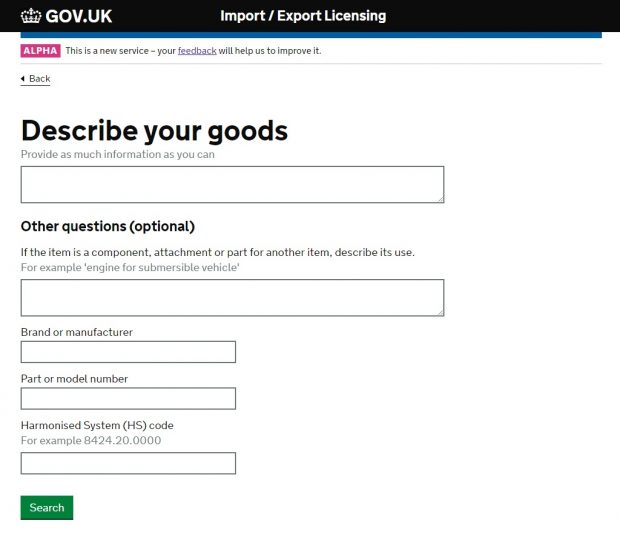Followers of this blog might be wondering what’s been going on with our prototype.
Our faithful friend has been with us since the distant days of our discovery phase. We’ve pushed out three or four major iterations of this prototype and made countless minor tweaks over these last few months, all in direct response to user feedback. But we’re now at the point where the prototype, while not being retired just yet, is no longer going to be updated.
This doesn’t mean we’ve stopped working on the SPIRE replacement service; this is no goodbye from us. What’s happening now is our development team are hard at work building the full service that will eventually go live online.
The prototype has served us well as a proving ground for ideas and as a way to respond to your feedback, but it lives in a bubble away from the other services it needs to connect with, meaning we’ve been able to hammer it hard in testing with no fear of breaking anything that matters.
But while our developers plough on with the tough work of building the full service that will integrate with all the back-end systems and technologies we’ve chosen, we’re still keen for exporters to use our prototype and tell us what they think. So here’s what’s been going on with it lately, to get it to its final iteration.
When is an export not an export?
While testing with non-expert users, we’ve realised that the language we’ve sometimes taken for granted in and around export control is not universally understood. Most notably, something that might obviously be an export to some might be anything but to others.
This led us to change the page that's intended to direct users towards import, export or other trade activities and the various licences for each. This is where this part of the prototype has ended up.

And we’re the first to admit that this might not be great. We’ve tried to focus here on covering as many bases as we can but this is perhaps the page we ourselves are least happy about in the prototype.
We haven’t yet had the chance to seriously test this page with users - it may yet get a positive reaction - so any feedback from readers of this blog about it would be very gladly received. Do the definitions of each option help? Are there too many words on this screen? Would you be happier seeing specific activities here instead, such as ‘I am taking items out of the UK for personal use’ and ‘I am selling items to a company overseas’?
When is a gun not a gun?
We’ve also retained the same set of goods categories we had from the start.

These may not be complete – waste needs to be added, for example – and how we handle dual-use goods here is a particularly tricky issue. We’re also mindful that military and non-military firearms should perhaps be separated from each other. These issues will be addressed in our next batch of testing so you can expect some changes in this area.
Streamlined search
Where we have updated things is on our ‘search’ page, to make it clearer that the additional fields are optional.

Testing has shown that experienced users are keen to see these extra fields. They’re also useful to help build up our database of keywords behind the scenes, making the results more accurate. But we’ve seen non-expert users worried that they need to hunt about for part numbers or HS codes, so hopefully making these very obviously optional will make this page work for everyone.
On the whole our search results page and the subsequent summary page for each individual classification in the Export Control Lists have been well received in testing.
This final version of the prototype has led us to split up subsequent pages, however. Anyone who’s looked at the full control lists will know that classifications are often accompanied by additional information, from items that seem to fall within a classification but actually don’t (known colloquially as ‘decontrols’), to complicated technical notes and specifications for goods, software and technology.
For any given classification you might see decontrols, additional specs that are too complicated or wordy to put into a short description of the item, or details on, for example, how to measure the ion beam current of electromagnetic isotope separators. We can’t just ignore this information – some exporters actively seek it out – and the prototype now incorporates many, though not yet all, of these extra bits and bobs.
Adding the registration process
Other screens in the prototype include the plainer-English OGEL summaries, which our test subjects have found very helpful so far, and the various screens required to register for an OGEL. This part of the process has only recently been added but isn’t hugely different to the registration process in SPIRE, OGELs being pretty straightforward to register for (you don’t need much more than your name and address).
Each screen in this prototype can and likely will be changed in the full build of the new service. As we ramp up the pace of our user testing we’ll continue to build on what’s in the prototype, but you won’t see any more changes reflected in it.
That said, as the backbone of what we’re trying to do, the prototype has been and continues to be hugely useful as a communication tool between ourselves and exporters keen to understand how and why we’re doing what we’re doing. We continue to value feedback on the prototype – you’ll just now have to wait longer to see that feedback taken into account as that’ll be in the private beta build (and subsequent public beta).
To let us know what you think about what we’ve done so far, or if you’re interested in helping us test the next iteration of the service, please get in touch with our user researcher Nataly at nataly.anderson@digital.bis.gov.uk.
12 comments
Comment by Christine Sumpter posted on
First time I've given it a go but went through exporting from the UK, Dual Use products wiith a description of 'civil aircraft engine'. The only option I got was ML10. I was not pointed to PL9009 or 9A001, for example. Which leads me to ask whether it was designed as a true working model?
Comment by James Curran posted on
Thanks for the feedback Christine, we are trialling two search engines (solr and elastic search), we have just tested the same scenario on our development system and solr returns the PL9009 and 9A001x matches. If you are available to come downstairs we can show you, any more feedback is welcome so that we can ensure the searches are returning the right results.
Comment by Maeva Evans posted on
Really good prototype overall. My colleagues and I had a go and we find the definitions and links very helpful especially for our newer team member. we have made note of a couple of points which seem to have been missed
1. Clear guidance on dual use goods transfer within the EU
When we tried Dual use goods 6A003b4b. to be shipped to France, Germany, Spain (within the EU) it advised on the below and that we may apply for a licence. This is not quite correct as no licence is required when shipping dual use goods within the EU as confirm by the OGEL Checker. It would be helpful for the information in the OGEL checker to be prepopulated into the response to avoid any confusion and unnecessary licence application.
Back
Based on your answers, no Open General Export Licences are suitable for your export. You may still be able to apply for a Standard Individual Export Licence (SIEL).
Apply for a SIEL using SPIRE
2. Clear guidance on technology for dual use goods
When selecting dual use goods technology to export the option given for identification of the goods does not provide any choice for “ technology relating to Dual use goods “ . All the options given point out at military classification. E.g. ML22 instead of Dual use 1E001.
I would be great for new users to be able to identify the classification of dual use goods technology and then obtain guidance on the appropriate , licence to use or apply for.
Thank you and keep up the good work!!!
Scott Safety team
Comment by James Curran posted on
Thanks for the feedback it is really useful, i'll feed it back into our design team. If you'd like to be involved with future testing with our user researchers, please let me know (james.curran@bis.gsi.gov.uk).
Comment by Duncan Millar posted on
Generally the process seems efficient and works well for the novice but it does also have the potential to mislead them.
By way of example we tested the system to send an ML6a item (Surplus Military Vehicle) to Zambia (a land locked country) and the system gave a standard non-committal response which stated that the exporter "MAY" be able to send the goods on an OGEL (Surplus Military vehicles).
What it failed to mention is that in order for the goods to be exported to Zambia, they have to go (usually) via Namibia which is subject to the need for a full SIEL for ML6a goods.
For the programmers..... can you not employ a conditional statement whereby if Zambia is selected (or any other land locked country) it automatically identifies the possible need for a SIEL depending on the initial port of entry prior to the goods transiting to the final destination of Zambia (for example).
It could then generates a statement like “The country selected is land locked, goods transiting to this country from the port of entry may require a full SIEL”
Comment by Chris Lockie posted on
Thanks for your feedback, that's very helpful. In the case of the military surplus vehicles OGEL, if the items are unloaded into a country, in this case Namibia, that country is considered to be the final destination. As Namibia is not an approved destination for this OGEL you will not see that licence in the list of results if you select Namibia for the final destination. You will see if if you select Zambia, but that's not considered the final destination in this case.
However, we can't assume exporters know this when they come to use the service. We will look at adding some clarity on this in future versions, most likely at the point the user selects their destination (either clarifying what counts as the 'final' destination, or using your suggestion involving an alert if the user selects a landlocked country).
Thanks again - that's exactly the sort of feedback we're looking for.
Comment by Christel Compliance PEI posted on
Will there be a link from there to apply to SIEl when we know our goods are not on the consolidated dual use and military controlled list that requires a licence for export? ie, when we have to apply to SIEL for end user concerns (typically, end use control over Russia for example)
I tried, and all i get to is "your good may not need a licence" - which is true in itself, the goods do not, but the end user do. How is this scenario managed?
Comment by Chris Lockie posted on
Thanks for your feedback. In the prototype, there are a number of different 'You may not need a licence' screens, and in most cases they should contain information on military end-use controls, WMD end-use controls, and also sanctions and embargoes. This information will include a link to apply for a SIEL on SPIRE if you have end-user concerns, because at the early stages of the new service users will be able to use it for OGELs, but SIELs will still be applied for through SPIRE (the post-beta phase will involve moving SIELs to the new service).
If that doesn't address your scenario, please give us more details and we'll take a closer look.
Comment by Marie Govan posted on
Just had a quick look at the prototype for the first time and it certainly looks very user friendly. My initial concern is with regards to exporters of parts & components. When the system asks "What are you exporting?" it doesn't make any mention to parts/components which could lead the exporter to answer 'none of the above' and if they also answer 'no' to the Dual-Use question it looks like the items would not require a licence which wouldn't necessarily be the case. I know the system can't really cover ever eventuality but I think it would be useful to mention on the "what are you exporting" screen that it could include parts and components for each of the listed categories.
Comment by Chris Lockie posted on
Thanks for the feedback Marie. We've had a few recent comments in using testing about how we're dealing with components and parts as opposed to complete products, so this is something we'll have to figure out how best to handle. It might be a matter of adding references to components in the descriptions of items, but we're concerned at making those descriptions overly long so we're considering various options around this. At any rate rest assured we're aware of this, and thanks again for your feedback.
Comment by Christine Bailey posted on
where can I find a link to the prototype
would be inerested to see how it works
Comment by Chris Lockie posted on
It's here: litetest.bis.gov.uk